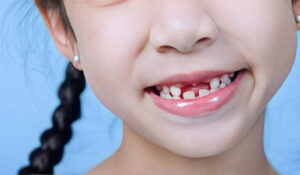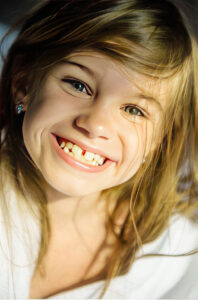
Is it okay if your little one’s teeth start erupting with spaces between them?
The short answer - usually spaces are okay, and can actually be a good thing! Here is some helpful information about the development of primary and permanent teeth and what causes different types of spaces.
Teeth Formation
A complete set of baby teeth is formed while your child is still in the uterus. When they are born, 20 little pearly whites are just sitting there under their shiny pink gums! Teeth erupt at different ages for every child. Their unique pattern and eruption rate depend upon many of your baby's individual DNA and other distinct characteristics. It also depends on how the gums and teeth are taken care of when they come in. In fact, the oral health of primary or baby teeth can impact your child's tooth development and the formation of their adult teeth.
Usually, a child has all of their primary teeth by the age of three. The significance of these teeth is vital as they help them when chewing and talking, and they are "place-holders" for their adult teeth. Because we usually have 20 primary teeth and 32 adult teeth (including wisdom teeth), there may be gaps where your child's baby teeth do not touch to allow room for all the adult teeth.
The usual sequence of baby teeth eruption is as follows (but remember that every child is different and some may come in earlier or later or in a different order):
- Six to twelve months of age – two bottom front incisors first, then two top front teeth
- Nine to sixteen months of age – the four teeth on each side of the front teeth, top and bottom (lateral incisors)
- Around thirteen to nineteen months of age – first molars
- Sixteen to twenty-three months of age – canines. These are the pointy and sharp eye teeth on each side of the lateral incisors (top and bottom). Your child's pediatrician may say your toddler can now eat foods that must be well chewed.
- Two years of age – the second set of molars, top and bottom
- Five to seven years of age – may begin losing baby teeth, and their first permanent adult teeth may begin erupting
Forty percent of children have spaces between their baby teeth. These gaps are typical and help greatly with the following factors:
- The permanent teeth have plenty of space to grow after the baby teeth fall out.
- Adult teeth will not be crowded and this may help keep your child from needing braces.
- It's much easier to brush and floss due to the spaces between the teeth.
- Teeth have less chance of decay because it is easier to clean all their surfaces.
Occasionally, spaces may be caused by missing teeth. Some children or adults have gaps due to tiny teeth. However, most babies have gaps between their primary teeth, which usually close when their adult (permanent) teeth come in.
Technically Speaking

Diastema is the medical term describing a gap between any of your child's teeth. It is most common in the upper front teeth but can happen between any of them. Diastema does not affect the function of your child's mouth or their oral health. In some cultures, a gap in the front teeth is a distinction of beauty.

The band of connective tissue that attaches the top lip to the upper gum is called the fraenum. You will easily see this structure if you lift your child's top lip (or your own). If the fraenum is oversized, it is the most common cause of gapped front teeth. The lingual fraenum connects the tongue to the bottom of the mouth. This fraenum can cause a gap in the front teeth of the lower jaw if it is restrictive and may cause tongue tie.
Gaps can be a result of heredity. Sometimes, the jawbone size is naturally large, and your kiddo's teeth look small compared to it. Their teeth are naturally spaced farther apart because of this. Once their adult teeth erupt, teeth will be closer together.
Children using a pacifier or sucking their thumb for a prolonged time can change the shape of the roof of their mouths and also cause teeth alignment problems.
Filling the Gaps
If a gap in baby teeth is due to a missing tooth (either because the child was born that way or because the tooth came out due to injury or decay), we may choose to leave it until adult teeth come in. We may also recommend a space maintainer, depending on your child’s individual situation. If the missing tooth is an adult tooth, we have options to fill the space and create the healthiest bite for your child.
Gaps in your child's baby teeth are generally not an issue and allow plenty of room for their adult (permanent) teeth to erupt and grow. The temporary gaps can positively impact how their smile fully develops. You can access the entire tooth for brushing and flossing on every side, and the dentist can examine every surface more easily. Starting these practices with your child early in life makes it seem routine and establishes sound oral hygiene habits.
Making your child's oral health a priority can affect how their entire body develops. Maintaining their teeth, beginning when their primary set erupts, can set the stage for a beautiful smile and healthy teeth and gums for a lifetime.
If you are concerned about spaces in your child’s mouth or have any other dental questions, we are happy to discuss them with you. It is our privilege to partner with you to keep your child’s mouth healthy!














